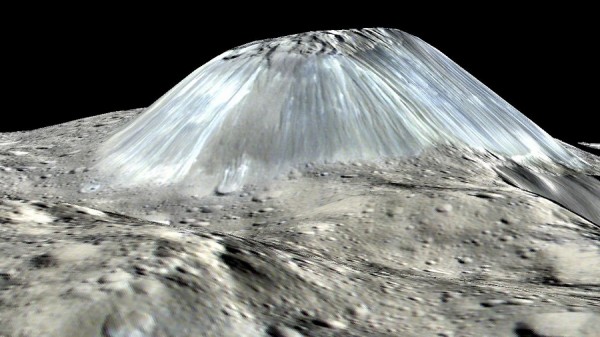By Ana Verayo, | February 04, 2017

Ahuna Mons seen in a simulated perspective view. The elevation has been exaggerated by a factor of two. The view was made using enhanced-color images from NASA’s Dawn mission. (NASA)
A new study suggests that several "cryovolcanoes" or ice volcanoes were once active but are now disappearing on the dwarf planet Ceres, which is located in the major asteroid belt between Mars and Jupiter.
"In our new study, we have gathered new evidence about the presence of many cryovolcanoes, however, they have been all deformed," Michael Sori of the Lunar and Planetary Laboratory from the University of Arizona, said.
Like Us on Facebook
Ahuna Mons is the only known cryovolcano on Ceres to date. However, scientists are still trying to determine why this mountain is isolated from other geological features. This cryovolcano is estimated to be as high as half the height of Mount Everest, possessing steeper and sharper slopes that are also a relatively young volcano. "Imagine if there was just one volcano on Earth, that would be really puzzling," Sori added.
The team has suggested that Ceres may have been host to more volcanoes in its geological past. However, as time passed, these ice mountains became deformed, almost being flattened on the surface of the icy dwarf planet.
Scientists call this deformation process on Ceres as viscous relaxation. It occurs when a liquid or semi-liquid objects become flat over time. On Earth, this phenomenon can be observed by moving glaciers.
In this new study, researchers demonstrated using a model how viscous relaxation works on cryovolcanoes on Ceres to shed light on how these mountains became flat and why Ahuna Mons remains solitary.
For Ahuna Mons to disappear onto the surface, the icy volcano should be made of more than 40 percent water. This new model determined that a Ceres cryovolcano made of 40 percent water can be flattened completely at the rate of 30 to 160 feet every 1 million years. This means that a cryovolcano will disappear into the ground in 700 million years.
Sori noted that Ahuna Mons is more than 200 million years, it will take more time for it to become completely deformed. This new study was published in the journal Geophysical Research Letters.
-
Use of Coronavirus Pandemic Drones Raises Privacy Concerns: Drones Spread Fear, Local Officials Say

-
Coronavirus Hampers The Delivery Of Lockheed Martin F-35 Stealth Fighters For 2020

-
Instagram Speeds Up Plans to Add Account Memorialization Feature Due to COVID-19 Deaths

-
NASA: Perseverance Plans to Bring 'Mars Rock' to Earth in 2031

-
600 Dead And 3,000 In The Hospital as Iranians Believed Drinking High-Concentrations of Alcohol Can Cure The Coronavirus

-
600 Dead And 3,000 In The Hospital as Iranians Believed Drinking High-Concentrations of Alcohol Can Cure The Coronavirus

-
COVID-19: Doctors, Nurses Use Virtual Reality to Learn New Skills in Treating Coronavirus Patients







